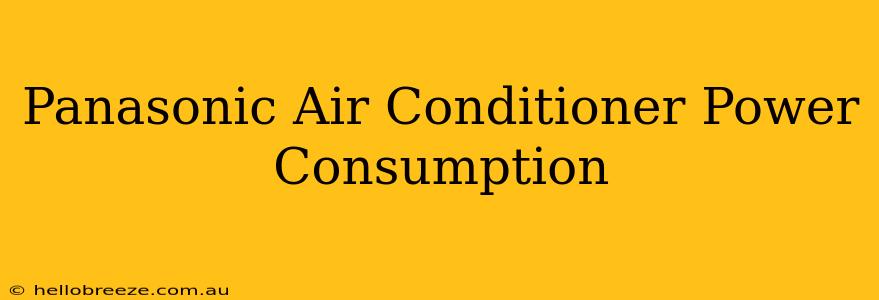Choosing the right air conditioner can significantly impact your energy bills. Understanding Panasonic air conditioner power consumption is crucial for making an informed decision and saving money. This guide breaks down everything you need to know about Panasonic AC power usage, helping you choose the most energy-efficient model for your needs.
Understanding Your Panasonic AC's Energy Consumption
Panasonic offers a wide range of air conditioners, each with varying levels of energy efficiency. Power consumption is measured in watts (W) and kilowatt-hours (kWh). Watts indicate the instantaneous power usage, while kWh measures the total energy used over a period of time (usually an hour). Your monthly electricity bill reflects your total kWh consumption.
Several factors influence your Panasonic air conditioner's power consumption:
-
Model: Different models have different energy efficiency ratings and power consumption levels. Newer models generally consume less energy than older ones. Look for models with high Energy Star ratings or similar energy efficiency certifications in your region. These certifications indicate that the unit meets specific energy-saving standards.
-
Cooling Capacity (BTU/h): Higher cooling capacity units generally consume more power. Choose a unit appropriately sized for your room or space. An oversized unit will work harder and use more energy to reach the desired temperature, while an undersized unit will struggle to cool effectively and potentially run continuously.
-
Settings: The temperature you set, the fan speed, and the operational mode (cooling, heating, fan only) all affect power consumption. Setting the thermostat a few degrees higher or using a fan only mode when appropriate can significantly reduce energy usage.
-
Maintenance: Regular maintenance, including cleaning the filters and coils, improves efficiency and reduces power consumption. A dirty air conditioner has to work harder to cool, leading to higher energy bills.
-
Inverter Technology: Panasonic offers inverter air conditioners, known for their energy efficiency. Inverter technology allows the compressor to vary its speed based on cooling demand, reducing energy waste compared to traditional on/off units.
How to Find Your Panasonic Air Conditioner's Power Consumption
The power consumption details are usually found in:
- The product manual: This will clearly state the power consumption in watts (W) and potentially kWh per hour under different operating conditions.
- The energy label: Many countries require energy labels on appliances. This label provides information on energy efficiency ratings and power consumption.
- The Panasonic website: Check the specifications of your specific model on the manufacturer's website.
Tips for Reducing Your Panasonic Air Conditioner's Power Consumption
Here are some practical tips to minimize your Panasonic air conditioner's energy consumption and lower your electricity bills:
- Choose the right size: Consult a professional to determine the appropriate BTU/h for your space to avoid oversizing or undersizing your unit.
- Regular maintenance: Clean or replace air filters regularly and have your unit serviced annually.
- Optimize settings: Set the thermostat to a comfortable temperature rather than excessively cold. Utilize the timer function and consider using the fan only mode when appropriate.
- Improve insulation: Proper home insulation helps maintain a consistent temperature, reducing the workload on your air conditioner.
- Utilize natural cooling: Open windows and doors during cooler times of the day to allow for natural ventilation. Close them during the hottest hours.
- Consider an inverter model: Inverter AC units are known for their superior energy efficiency compared to non-inverter models.
Choosing an Energy-Efficient Panasonic Air Conditioner
When selecting a new Panasonic air conditioner, prioritize energy efficiency. Look for models with high energy ratings, such as Energy Star, and consider the following:
- SEER Rating: The Seasonal Energy Efficiency Ratio (SEER) measures the cooling output over an entire cooling season. A higher SEER rating indicates greater energy efficiency.
- EER Rating: The Energy Efficiency Ratio (EER) measures the cooling output for a specific operating condition. A higher EER rating also indicates better energy efficiency.
By understanding your Panasonic air conditioner's power consumption and following these tips, you can significantly reduce your energy bills and contribute to a more sustainable lifestyle. Remember to always refer to your specific model's manual for detailed information and recommendations.

